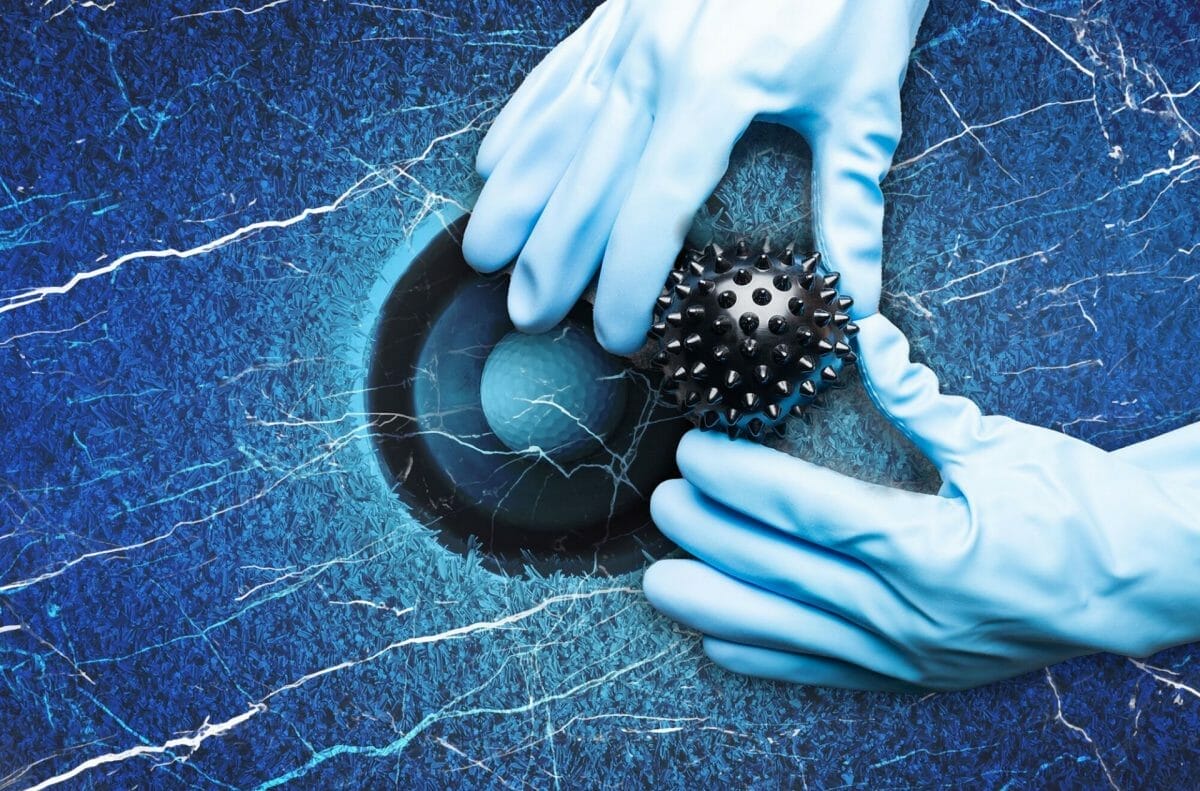It’s hard to contemplate, imagine or indeed even recall the scale and scope of the optimism that surrounded the professional golf scene as 2019 turned to 2020. Even in the depth of a northern hemisphere winter and the searing summer heat south of the equator, the new year promised much to savour for those with both a passion for and a passing interest in the elite side of the game.
The Masters – that annual signal that golf is back and out of hibernation, Tiger Woods’ defence of the realm, the icing on an already appetising cake. The prospect of four ‘Majors’ shoehorned into as many months, fast forward to the Olympic Games in Tokyo, not to mention the 43rd Ryder Cup, back on US soil in front of huge, fiercely patriotic fans at Whistling Straits.
And as 2020 dawned, the wind was also in the sails of the women’s professional game, the LPGA promising its strongest schedule since the 2008 financial crisis, the Ladies European Tour safe for now, sheltering under the wing of its powerful American sister, the LPGA, a philanthropic R&A and the, for now at least, troubled European Tour.
And then, everything changed, slowly at first with reports of a new, ‘Coronavirus,’ affecting the Chinese city of Wuhan, gathering momentum as intensive and interconnected global travel exported and imported the virus. Europe, Italy, Spain, France and the UK were first in the firing line, then across the Atlantic, which is where, for golf, the game changed, absolutely for the time being, arguably – we shall see – for a long time.
Many strange things have been taking place during Covid-19 lockdown, unusual events, odd happenings, banks showing empathy for their customers, rush-hour trains running on time and with seats to spare, toilet rolls flying off the supermarket shelves, but, by mid-March, the most extraordinary headlines started to appear across the media.
No, not prices in the shops slashed to zero, or free holidays for all, free fuel at the pumps – no – not even the appointment of the first black woman as captain of Augusta National Golf Club.
But, due to the newly-named health emergency called, ‘Covid-19,’ the PGA Tour, and its European, Asian and female relations were forced to call a halt, shut up shop as the world went into lockdown. Golf courses closed, professional tournaments at best deferred, at worst cancelled or – as was the case with the Holy Trinity of events, the Open Championship, the Olympic Games and the Ryder Cup – postponed until 2021.
By mid-March, the PGA Tour and its satellites, including its subordinates like the PGA Tour China-Series, the second-tier Korn Ferry Tour and the over-50s Champions Tour were placed in cold storage along with the European Tour, the LPGA, the South African Sunshine Tour and the Asian Tour.
The prestigious US$9.3m Arnold Palmer Invitational at Bay Hill became the last significant event before the PGA Tour portcullis came down, eight events, including the Players Championship were cancelled outright, others, including The Masters, the USPGA Championship and the US Open delayed until the tail end of a vastly reconfigured season.
And it was the same story on the LPGA circuit, one ‘Major,’ the Evian Championship lost to the virus, tour officials fighting like crazy to retrieve the rest from the wreckage, but, with infections rates rising exponentially once again, the most important women’s circuit in golf hangs in the balance for this year at least.
Across the pond, a three-month hiatus hit the European Tour, 20 tournaments worth a combined US$90m, either cancelled, postponed or devalued, including the Open Championship, whilst in Asia – where traditionally, tournaments are not played in the mid-summer months, 10 events were either lost or adversely affected on a circuit that is arguably least robust enough to withstand the onslaught that is Covid-19.
Then, the two killer blows, the undoubted highlights of an already highly-promising 2020 season were announced, the worst-kept secrets in golf, the Games of the XXXII Olympiad in Tokyo, Japan and the 43rd Ryder Cup, both provisionally kicked into 2021 on the assumption – still far from certain – that the wrecking ball that is Covid-19 will have completed its deadly work and either gone away or been tamed by therapeutic treatment or preventative vaccine.
Professional golf was on its knees, figuratively on the canvas, down and all but out, until the most surprising headlines of all, such as, ‘PGA Tour Advocates Mass Testing and Transparency,’ began to appear, all in a rear-guard effort to not only save the season but, potentially, to save their entire edifice.
The only missing words were, ‘Drug,’ or, ‘Dope’. Instead, ‘Coronavirus.’
And, in sharp contrast to the inherent secrecy surrounding and implicit paucity of drug testing on the world’s premier golf circuit, on 27th June, the PGA Tour issued a statement entitled, ‘Covid-19 Testing Update,’ which read, ‘Positive Covid-19 cases with arrival testing complete (2,757 total in-market tournament tests over three weeks; 7 positives (including Cameron Champ, player, Denny McCarthy, player, Bud Cauley, player, Nick Watney, player, Ken Comboy, caddie).’
Further, regular and detailed updates have followed.
Just imagine two parallel testing issues for a moment; first, that the very being of the week-in, week-out, multi-million-dollar sporting circus that is the PGA Tour depended, for its very existence, on mandatory mass testing for performance-enhancing and recreational drugs.
And second, that the total number of tests taken, statistical breakdown of positives and negatives and the identities of those returning a positive test were routinely and voluntarily published by the PGA Tour.
Now that, without question would be a game-changer, a welcome innovation that would not only enhance and embellish a somewhat sullied reputation of professional golf and, at a stroke, sweep away legitimate and lingering doubts that have – if not haunted, then certainly hounded – the PGA Tour its siblings and its members for decades and more.
But, given its record on ‘Testing’ of that other, more controversial sort, namely, ‘Drug testing,’ over which the PGA Tour and, to a lesser extent its European cousin has been, shall we say, politely, ‘Less than enthusiastic,’ and with transparency a definite no-no, failed doping tests – for both recreational and performance-enhancing substances – concealed under the guise of, ‘Member confidentiality,’ ‘Player privacy.’
But despite a significant shift in its doping control policies ahead of the 2018 season, which included the use of blood testing as well as urine sampling and the adoption of the International Olympic Committee (IOC) list of banned substances, as well as a commitment to, ‘Name and shame’ those who violate the rules, still, neither the PGA Tour nor the European Tour is willing to divulge the number of drug tests conducted in 2018 or 2019.
The most recent available, official information is that the R&A oversaw a grand total of eight drug tests at the 2016 Open Championship, nothing said concerning any outcome, whilst the St Andrews-based organisation was willing and able to confirm that as a result of another type of testing – like drug testing, to expose any attempt by a player to gain an unfair and illegal advantage, US star Xander Schauffele’s Callaway Epic Flash driver was tested and found to be, ‘Non-compliant,’ or, in layman’s terms, ‘Illegal,’ ahead of last year’s epic Open at Royal Portrush.
Such institutionalised deception over drug testing inevitably still leads to the implication – real or imagined, it doesn’t matter – of a, ‘Don’t look – won’t find,’ approach to an underlying, uncomfortable subject that has blighted professional golf for years.
“We believe that these changes to our program are prudent in that they further our objectives of protecting the well-being of our members and better substantiate the integrity of golf as a clean sport,” PGA Tour commissioner Jay Monahan said recently, yet only two players, Matt Every (OWGR #335) and Robert Garrigus (OWGR #1,284) – neither exactly high-profile players or household names – have been caught in the supposedly widening net.
And golf at the elite level is a sport where muscle mass and brute strength are now essential parts of a top player’s armoury, where quick and effective recovery from injury professionally and financially is a must, where a steady hand and a calm mind can literally be the difference between winning and losing.
Meanwhile, outside the ropes, with hundreds of young players – mostly men – transient and en masse, with time on their hands and cash to burn, if golf is indeed a reflection of other high-value professional pursuits, such as rock music, movie making and even the high-octane end of the financial services sector, it would be – frankly – astonishing if recreational drugs were not present and arguably to some significant extent.
But when PGA Tour enfant terrible Dustin Johnson tested positive three times, in 2009, 2012 and 2014, first for marijuana, then – twice – for cocaine, these misdemeanours were never officially announced; the player himself revealing he was taking a six-month break from golf to deal with, “personal challenges.”
All of the above, individually and collectively, performance-enhancing and recreational drugs – debunk and unmask golf’s greatest myth, the long-held, official line that, ‘There is no drug that can assist a golfer or their performance.’
At the time of writing, 60 of the top male and female players in world golf would be taking to the hallowed turf at Tokyo’s Kasumigaseki Country Club, where notoriously stringent doping control protocols would have been in place, with all qualified golfers having had to adhere to the IOC testing regime for three previous months.
The comparatively stringent and intrusive pre-Olympic drug testing system, which itself became a casualty of the COVID-19 pandemic in many countries, include the controversial, ‘Whereabouts,’ provision, requiring players to routinely notify independent testers where they would be for one nominated hour each and every day of the year and to be available to supply a sample on demand, with three strikes (missed tests) and they’re technically ‘Out,’ three missed tests the equivalent to a failed, positive test, a protocol far in excess of any golf tour’s normal drug testing procedures.
But, with the immediate – and potentially longer-term future of the sport, and the very livelihoods of their members on the line in the ‘New normal’ Covid-19 landscape, Tours and their members (remembering the players are actually part-owners of the circuits they compete on) openly, willingly and voluntarily performed a screeching U-turn, suddenly embracing, ‘Testing’. A word that would previously send shivers down the spines of golfers and officials was suddenly and undoubtedly the only viable pathway back to competitive golf and the barrow-loads of cash still available, on the PGA Tour at least.
Out of nowhere, headlines such as, ‘Third PGA Golfer Tests Positive,’ ‘Harris English Becomes Fifth PGA Tour Player to Test Positive,’ and, ‘Champ’s Positive Test & McDowell’s Withdrawal Add to PGA Tour Trouble,’ began appearing, not for performance-enhancing drugs like Anabolic Steroids, Human Growth Hormone or Beta Blockers – not even recreational substances such as Cocaine or Marijuana, but for the previously unknown Covid-19 as the virus went about its disruptive and, all-too-often, deadly business.
It’s truly amazing what one might find if one rigorously and routinely goes looking, and, as professional golf gets back underway – largely as a made-for-TV sport with spectators either precluded or restricted – it begs the question, were drug testing to be given the same priority as its new-found cousin, the routine, rigorous search for Covid-19, both as an ethical, safety and healthcare issue, just what might the testers find, and to what extent?
It remains an open question as to whether the Tours’ recent conversion to the absolute need for testing for one vital purpose might lead to an appetite for another equally important imperative for testing – this time of the doping variety. Going forward, the drug taking that is inevitably going on to a greater or lesser extent (no one knows which) is, unlike Covid-19, not simply a health and wellbeing, possible life or death concern but an ethical, moral and potentially legal issue.
Were drug taking in sport to be dealt with in the legal rather than sporting sphere, where criminal offences for possession and trafficking, and the even more punitive charge of fraud, obtaining (prize) money by false and illegal means, with the full public disclosure of the courts, perhaps players and officials might start taking the issue rather more seriously.
But through governing bodies like the International Golf Federation (IGF) and the International Olympic Committee (IOC), professional tours including the PGA Tour and organisations such as the World Anti-doping Agency (WADA) and the Court of Arbitration for Sport (CAS), sport and players are effectively told they operate largely outside the law and enjoy a free pass of the type other ordinary citizens are denied.
Of course, nobody is suggesting that drug testing in sport in general and golf in particular is anywhere near as important as testing for Covid-19 where lives – hundreds of thousands of them around the world – are literally on the line, but, when life returns to normal, whatever that may look like, ethical sport will still be there and potentially as open to abuse as ever.
But, given that IOC-style drug testing, 24/7, 52 weeks of the year would be viewed – one suspects – by professional golf as a ‘Threat’ rather than the ‘Opportunity’ they perceive Covid-19 testing to be, despite the World Health Organisation mantra of, ‘Test, Test, Test,’ to ascertain what you are dealing with, when it comes to catching the drug cheats who are inevitably playing with impunity, Bunker Mentality says, “Don’t hold your breath.’























Leave a comment